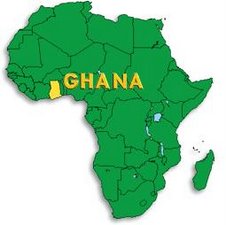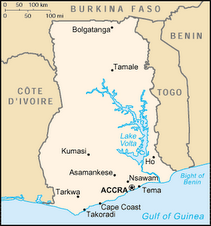Ghana has a national health insurance that costs $8 per person per year. Many people cannot afford this and therefore, when they become sick they have to pay before being seen and treated. Since the average Ghanaian earns $2-$7 per day, it can be a hardship to first pay $3 to register at the Out Patient Department and then pay another $5 to see either the eye specialist or myself (or even the ophthalmologist or otolaryngologist nurse practitioner). Pre-surgical blood tests and surgical costs add another $16 or more. Many patients who should be admitted for hospitalization decline because of cost or fear. There is no other Ghana welfare system in place, that I know of, to allow for the indigent to receive care.
Two children were seen last week - a five year-old girl with a piece of chalk in her nose and a three year-old boy with a coin in his esophagus. The families of both chose not to return for the needed procedures. One was probably due to the cost charged by the hospital while the other expressed fear of the child dying during general anesthesia and oral-esophageal extraction of the coin. A third patient, an elderly man with a superficial, skin cancer on the neck, simply refused treatment because for him, surgery meant death. The chance of dying during these procedures is less than one in two thousand and without treatment, death is a possibility in the child with the coin obstructing the esophagus and the gentleman with the skin cancer.
Unfortunately, patients arrive in a late stage of disease after having tried everything else, - herbal remedies, diviners, etc. A five year-old girl, having Burkitt's Lymphoma, presented last Wednesday with a deformed cheek, hepatomegley, and an abdominal mass. Regrettably, her prognosis is extremely poor. It was recommended that she travel 200 miles to the medical school in Kumasi for chemotherapy, which is also a financial burden for the family. The young father asked me for help to bring the child to Kumasi.
There are many chronic ear infections with perforated eardrums and referrals come from hundreds of miles. The nurses mentioned they've heard a radio announcement about the arrival of an ear, nose and throat specialist in Tamale so word is spreading. Before I came, there was no physician in the Ear, Nose and Throat (ENT) clinic and as I may have noted before, none with my training in the entire Northern Region. The north's population is five million and people here feel they have been neglected by the government in comparison to those in the south. At any given day, hundreds of patients line up early at the hospital to be seen and when the few doctors on staff are gone at the end of the day shift, the examinations are performed by nurse practitioners.
One problem situation for me is dealing with the deluge of hospital staff personnel and their family members who have virtually no medical problem but want to be examined. It's a constant battle to make them wait until the end of the clinic so we can see the people who are genuinely sick. And, more often than not, the patients with the most serious diseases appear at the end of the day.
Thursday, I performed a nasal and sinus operation on a sick man who three months before on a diviner's recommendation, had placed an herbal treatment into his nose and as a result developed fistulas draining into his cheek and mouth; he also had an osteomylitis of his orbital rim. I successfully commandeered the TV from the OR lounge and used this as a video monitor for the camera attached to the sinus endoscope. The nurses were impressed with the technology as they were able to see on the TV screen the internal nasal and sinus anatomy as the operation progressed. This equipment, donated by JedMed and Karl Storz, along with a pulse oximeter from Nelcor, a headlight from Surgitel, and many other instruments generously donated by various medical companies, has been a godsend. A Pillings light source acquired several years ago still works too. My sterilizer, brought over in the container, is also set up and functioning well. Previously, clinical sterilization consisted of boiling the instruments half out of the water in an emesis basin for a few minutes. Special thanks go to my very capable and hard-working medical secretary in Kearny, Carolina, who spent innumerable hours arranging and packing all the equipment for transport.
In any event, the medical care denied or unavailable to so many people because of their inability to pay the fees set in place by both government hospitals and private clinics is disturbing. Because I am presently trying to practice within the system of a government run facility, patients are first obligated to pay the hospital charges before being treated by me. Perhaps I can hope to circumvent this situation as best I can by covering the cost of those cases I judge to be truly in need with some of the funds donated for my work here.
Every day is a learning experience, - never dull, often frustrating and always challenging.











